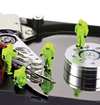Data recovery with the TestDisk/PhotoRec duo
|
To conduct this test, I destroyed a partition table and deleted about 600GB of data. Then, I let TestDisk and PhotoRec show what they could do. A common saying for hard drives is that they have just three states: empty, full, and damaged. The latter two states occur more frequently than most users would expect. Damage to a hard disk has the habit of occurring quite unexpectedly once symptoms of mechanical fatigue appear.
Until a few years ago, all hard disks were mechanical. Users could therefore sometimes hear clacking noises when a hard drive was nearing the end of its life. They could then change out the drive before it became inaccessible. The SSD drives today are different; they die quietly.
One indicator that can be used to determine the health of a hard drive running under Linux is the hard drive monitoring software S.M.A.R.T. [1]. The Linux Smartmontools [2] can process and interpret the data for signs pointing to wear and tear of the drive. However, if the hard drive is no longer accessible, but is still visible from the BIOS, or if a partition or data within a partition have accidentally been deleted, then it is time to use the forensic tools TestDisk and PhotoRec.
[...]
Buy this article as PDF
Pages: 4
(incl. VAT)






